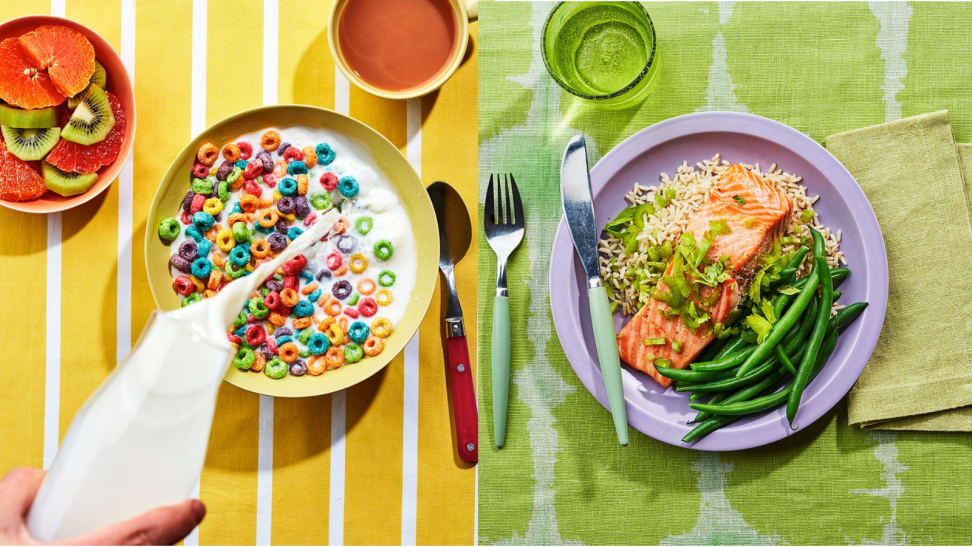It is touted as the trendiest way to lose weight, but does it work? We put Noom to the test.
You might have seen advertisements for Noom pop up before a YouTube video or on your social media and wondered: is this just another tried and true app promising weight loss and not delivering? Is this really going to work? What exactly makes Noom different?
We’ve seen advertisements for Noom and wondered exactly the same thing. So, we figured we’d get one of our writers to strap in for two months and give it a try.
Trying to find a weight loss program that works is nothing short of an ordeal. Often, it seems there are a billion different voices creating a chorus of utterly contradictory opinions – should I do Keto or High-Carb Vegan? Does CICO really work? What about Intermittent fasting? And OMAD? Or Gluten Free? Or what about those meal-replacement shakes?
Social media, too, often makes it difficult to discern what is real and what isn’t. How come one of my favourite fitness models with ripped abs and toned legs swears by Keto while the other one is a Vegan?

The Psychology of Weight Loss
Noom preaches that they are committed to not simply getting results, but changing the way we think about food by using Psychology. Every day you are asked to complete short, 10-minute “lessons” about the psychological reasons many people struggle to lose weight, and how to overcome these.
Noom provides excellent tools for dealing with temptation, dealing with feelings of failure that come if you go over your daily caloric limit and mechanisms to avoid temptation, binging or falling off the diet bandwagon.
Of course it isn’t the same as having a psychologist sit down with you and explore the specific reasons why you personally struggle to lose weight, but the ideas from Noom are extremely helpful regardless. Our writer who tried it said” I will certainly be incorporating these coping mechanisms in my daily life, long after my Noom subscription expires.”
Caloric Density
Another one of the saving graces of Noom is that it simplifies the struggle of finding the “right” diet. Noom isn’t strict about whether you love a good Barbecue or you’re a committed Vegetarian – rather, its focus is on the volume and calorie count of food you’re eating.
Noom teaches that the most successful method of losing weight is to focus on consuming high-volume, low-calorie foods. Numerous scientific studies suggest that your stomach isn’t particularly concerned by the calorie content, but rather, the volume of the foods you’re consuming. Noom claims that you’ll feel just as full from 200g of grapes as you would 200g of raisins. 200g of Grapes, however, come in at 134 calories, where 200g of raisins has 598.
So, Noom has a way of categorizing food based on its caloric density – that is, how many calories per gram that food contains. These categories are labelled Green, Yellow and Red foods. Unsurprisingly, fruits and vegetables are Green foods. Foods like bread and lean meats are Yellow Foods – they have a higher calorie density, but not too high. Red foods have the most calorie density, including things such as oil, red meat, chocolate, full-fat dairy and even nuts and seeds.
The aim was for the majority of the foods to be Green foods, and to consume as few Red foods as possible.

Writer Sydney Earnshaw who road tested Noom says:
I had a few issues with this system. Firstly, while their ideas about caloric density are certainly backed by science, they don’t exactly tell the whole story. Noom doesn’t focus at all on tracking macronutrients, despite the fact that many scientific studies have shown that focusing on getting enough protein will keep you fuller for longer, and that tracking your carbohydrate intake is critical for weight loss.
In fact, foods such as nuts, 100% peanut butter and whole yoghurt are classed as Red foods and to be avoided, despite the fact that consuming high-protein foods such as these are often cited as a key component to weight loss.
Moreover, despite being calorically dense, many of the Red foods are still healthy and nutritious, and shouldn’t be eliminated completely from one’s diet. If a handful of nuts is going to keep you full until dinner, then it’s a good snack – yet Noom’s one-track policy about caloric density demonises these foods. At the end of the day, the moralising colour-coded system made me feel nervous about eating protein or other foods that were “calorie dense” yet that I still deemed nutritious and filling.
Group Work
Diets can often be isolating, particularly if you’re the only person on one in your immediate friendship group or in your family. Seeing your loved ones chowing down on chips doesn’t exactly inspire you to keep eating your measly salad.
But one of my favourite things about Noom was the support network that came along with it – you had access to a Coach who checked in with you once a week, and after two weeks, you were placed in a forum-like group chat where you could air your concerns, struggles, goals and achievements.

1200 Calories A Day?
Noom’s most critical downfall for me, however, was their 1,200-per-day calorie limit. According to nutrition expert Ursual Philpot, a 1,200 calorie daily limit can potentially be extremely harmful – for others, however, it could be totally fine. The thing is, as Ursula Philpot elucidates, someone who is overweight, elderly or completely sedentary might be fine eating 1,200 calories per day, but for the average individual, this caloric intake can actually come with some serious consequences.
Philpot, who is a spokesperson for the British Dietetic Association, says that on a 1,200 calorie diet, your body will be forced to make metabolic adjustments (that is, it will actively slow down your metabolism) and that it can lead to food-related anxiety, an unhealthy preoccupation with food, and even temporarily shutting down a woman’s fertility, causing them to lose their period. Secondary amenorrhea, as this is known as in the medical field, may even have long term consequences for fertility.
For me personally, the 1,200 calorie diet was in no way sustainable, and even at times seemed to contradict the psychology-based, fruit-and-vegetable approach to dieting that Noom was otherwise promoting. As a relatively active 23 year old woman, 1,200 calories was simply not enough.
More than this, I found it very difficult to plan my own meals while attempting to eat under 1,200 calories per day – which doesn’t give you much wiggle room at all. Since there were no strict meal plans to adhere to, I truly did find myself becoming anxious and preoccupied with food – I essentially had to ration each of my meals, and any spontaneous dinner plans, afternoon snacks or even an evening beverage would completely derail my efforts, making me feel like a failure. Because of this, I would often end up going over 1,200 calories – usually settling between 1,600-1,800 – and these “high” numbers would make me convinced I should just give up.

What surprised and annoyed me most about Noom was the lack of tailoring in this department. After all, there are many, very simple ways to figure out how many calories one should be eating per day that are significantly more personalised and would lead to more effective weight loss.
Firstly, calculating one’s BMR (Basal Metabolic Rate) is critical. That’s the amount of calorie you would burn if you were laying in bed all day; the amount of calories your body needs simply to fuel its organs. For me, I was shocked to discover that my BMR was 1,350 calories, which meant that on Noom’s diet plan, I would be consuming fewer calories than my body needed to function.
Next, you figure out your TDEE (Total Daily Energy Expenditure). This takes your BMR and adds on the calories you would likely burn throughout the day based on your activity level – a sedentary person would burn fewer calories per day than someone who was fit and hit the gym three or four times a week. Noom, however, never asks for information about your activity level, which is critical when calculating many calories one is meant to be eating for sustainable weight loss.
For me, I would have been happy eating around 1,500 calories per day, but the 1,200 was a struggle. It made me feel bad both physically and mentally.

The Results
I didn’t end up losing much weight with Noom, and I think there were a lot of factors which contributed to that. Firstly, even though Noom claimed that they were focused on permanent lifestyle changes and didn’t require you to cut out certain foods, I still felt extremely restricted. The 1,200 calorie diet simply wasn’t working for me, and especially coupled with the fact that there were no meals plans or guides on how a day of 1,200 calories looked.
However, I wouldn’t call Noom a “failure” – in fact, I did enjoy my time using the app, and learnt a lot about psychology and calorie density that I didn’t before. The honest take-away is that, like all diets, Noom isn’t a one-size-fits-all. Having always been dreadful at calorie counting, time-poor and craving a meal plan to take the stress of choosing away, Noom wasn’t the best fit for me.
Trying to limit my caloric intake to 1,200 a day while still going to the gym, having a social life, working and, frankly, trying not to be miserable and hungry (well, hangry, that is) all the time was impossible. I would have been much more comfortable with a more attainable caloric goal, such as 1,500 or 1,600 per day, which would have been more sustainable for me.
I also noticed that the calorie limit was not tailored to me personally – I noticed that other people in my group were eating the same calories as me despite many of them being older than me (and thus having slower metabolisms) and have sedentary lifestyles. The daily caloric expenditure between me and others on my group would be drastically different – so why were we both on a 1,200 calorie diet?
This was the main reason I felt that Noom did not work for me. The psychology behind it was interesting and informative, yes, but at the end of the day it just felt like I was starving myself in a unsustainable way. I was stuck trying to “resist” my “cravings” when really, I didn’t want an entire bar of chocolate or a pint of ice cream – I just wanted a sandwich without having to have a measly salad for dinner.
There were pros and cons to Noom – ultimately, the diet didn’t work for me, but that doesn’t mean it can’t work for you!



